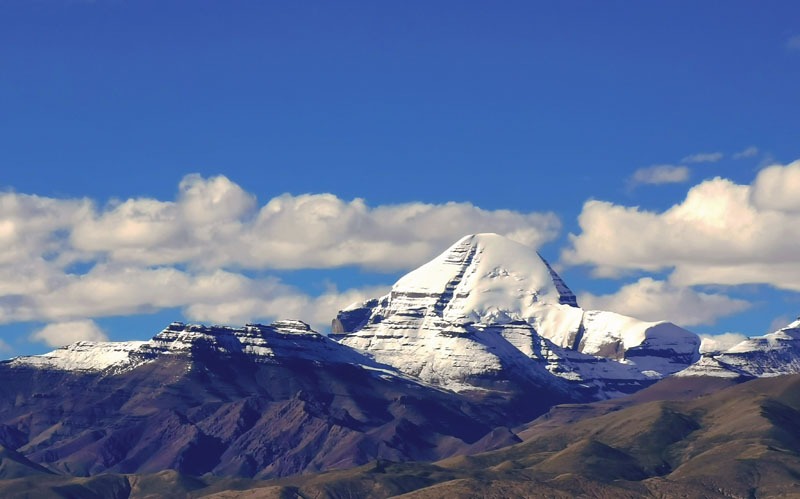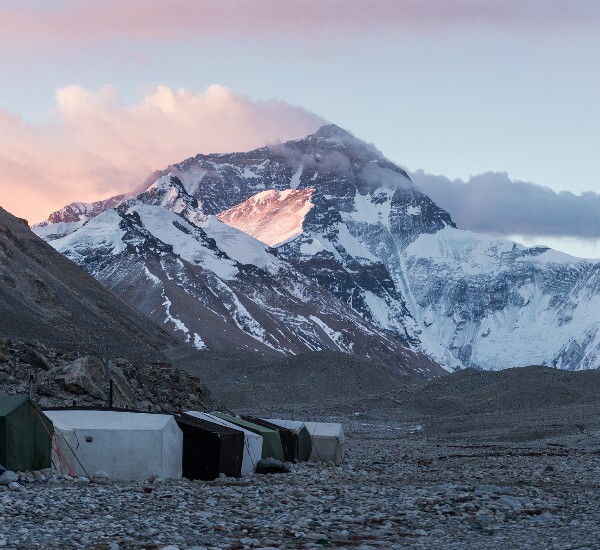For centuries, Mount Kailash has been also a holy place for four faiths and adventurous explorers, but it has never been climbed. Here, we provided a full guide including some background info, the highlights, Mount Kailash trekking, and how to get there.
Content Preview
- Why Is Mount Kailash Famous
- Where Is Mount Kailash
- How to Get to Mount Kailash
- Documents Needed for Mount Kailash
Why Is Mount Kailash Famous?
Mount Kailash— "the Stairway to Heaven"at 6,638meters (21,778 feet) high is the most famous peak of Kailash mountain range. Climbing it is not permitted due to its sanctity.
 Mount Kailash
Mount KailashIt is recognized as a sacred mountain by four religions: Tibetan Buddhism, Hinduism, Bön, and Jainism. In Hinduism, Mount Kailash is where Shiva (the Supreme Being) resides.
In Tibetan Buddhism, it's the home of the Buddha Demchok (representing nirvana).In their scriptures, Mount Kailash is considered to be the world's center or the point where heaven meets earth.
A beautiful lake, named Manasarovar, lies near the base of Mount Kailash is one of the highest fresh water lakes in China.
The Kailash region is (close to) the source of the main famous rivers in South Asia, the Indus, Ganges, and Brahmaputra.
Every year, thousands of pilgrims come to Kailash for a yatra —a pilgrimage journey, which may include a kora —walking around the mountain.
To find out more about Kailash Yatra
Where Is Mount Kailash?
Mount Kailash is on the southwest edge of the Tibetan Plateau in Ngari (Ali) Prefecture, western Tibet, near the borders of the PRC, Nepal, and India. It is about a 1,200 km (700 miles) from Lhasa and about 800 km (500 miles) from the Gyirong border with Nepal.
Mount Kailash is deep within the Kailash Range (the Gangdise Mountains), as its second highest peak. The Kailash Range, western part of the larger Trans-Himalaya Range, runs through the southwest of Tibet, parallel to the Himalayas.
To find out more about Kailash Facts
Recommended Tibet Tours:
How to Get to Mount Kailash
From Lhasa
Lhasa is about 1,200 kilometers (700 miles) from Darchen (Baga Township at the foot of Kailash) and the journey takes about 2 days.
Most people start in Lhasa with a visit to the Potala Palace and its surrounding ancient monasteries to acclimate, then drive to Shigatse and stay overnight. Then they go on to Darchen via Saga and Payang. It is better to spend a day acclimatizing in Payang before reaching Darchen.
Along the way you can visit the Yamdrok Lake and view the snow-capped mountains, beautiful grassland, and local's villages.
Recommended Tibet Tours:
From Kathmandu
From Kathmandu, you can take an off-road vehicle to the Nepal-China border at Gyirong Port. The distance is only about 170 kilometers (100 miles), but the journey by road may take 8 to 12 hours due to the poor condition of the road.
Taking a helicopter from Tribhuvan International Airport is a good option to avoid the bumpy road, and it is faster and safer. The journey by helicopter costs about 120 USD, takes 20 minutes, and takes you to a helipad near Gyirong.
Stay for one night near the port and pass through the port to the Tibet side. The drive from Gyirong to Mount Kailash is about 670 kilometers (420 miles) and can be done in one day as the road is well constructed. You will arrive in Darchen, a small town located at the foot of Mount Kailash.
If you travel with us, we and our cooperative partner in Nepal will help you to manage all of the transportation and accommodation. Although this could be a long journey, we will do our best to offer you a smooth experience.
To know more about Enter Tibet from Nepal
Recommended Tibet Tours:
Documents Needed for Mount Kailash
No matter whether you enter Tibet from Nepal or China, you need to apply for a China visa in advance. See how to apply for a China visa. You are advised to apply for it 2 months before your trip.
If you are traveling in a group with three or more people and planning to enter Tibet from Nepal, you can apply for a group visa in Nepal.See how to enter Tibet from Nepal.
A Tibet Travel Permitis needed to visit Tibet, and an Aliens' Travel Permit and a Military Permit are needed to travel as far as Kailash. If you travel with us, we will help you to get them.
See How to Plan a Tibet Trip in 2021 — Suggestions and Ideas
Documents and Policy for Indian Travelers
For Indians who are traveling as pilgrims to Mt. Kailash, or are including Kailash as part of their tour, there are a separate set of rules for Tibet Permits.
The Tibet permits and China Visa are handled by the Tibet-India Pilgrim Reception Center. It is the only organization that can arrange Indian travelers' visits to the Mt. Kailash area.
China Highlights is unable to organize Indian travelers' visits to the Mount Kailash area (Ngari), however we are happy to help with Tibet tours in other parts.
Check more options of Tibet Tour or contact us to tailor-make your trip
Mount Kailash Weather
The climate in Tibet is generally cold and dry. In remote western Tibet, the climate is even colder and drier. Near Mount Kailash, snow falls even during the warmest month of June.
On an average day, the temperature reaches as high as 14°C (57°F) and as low as -12°C (10°F). The average difference between the day and night temperature is around 14°C (25°F). The nights are much colder than the day.
Best Times to Visit Mount Kailash
Late spring to early autumn (May to September) is the best time period to visit Mount Kailash for warmer (above freezing) weather.
 Barley Harvest in September
Barley Harvest in SeptemberThe monsoon rain comes in summer (July and August), but it usually rains at night and then only lightly, so the weather will not affect a trip too much.
If you are going to do a yatra around Mount Kailash, summer is the best time because of the warmer temperature and higher oxygen content.
In winter, heavy snow will seal the mountain passes.
Also to find out Best time to Visit Tibet
Recommended Tibet Tours:
Things to Do When Visiting Mount Kailash
1. A Mount Kailash Pilgrimage (Kora)

Kailash is not allowed to be climbed, so most people choose to do a kora (trek around Kailash) to express their admiration for the sacred site.
In Hinduism and Tibetan Buddhism, it is believed that a yatra (pilgrimage) can eliminate the evils of their life and secure safety/blessing fort heir families. A Kailash yatra is a part of their spiritual life.
A Kailash kora is 3-day trek. The distance around Mount Kailash is 56 kilometers (35 miles) with a lowest altitude of 4,675 meters (15,338 feet) at Darchen and a highest of 5,648 meters (18,530 feet) at Dolma La Pass.
Devout Tibetans prostrate themselves on the ground after every few steps in worship. They do it to attain religious merit. It usually takes them 15–20 days to finish the kora this way
2. Lake Manasarovar
Manasarovar is 32 km (20 miles) by road from Mount Kailash (Darchen) and has an elevation of 4,590 meters (15,059 feet). Manasarovar is one of the biggest fresh water lakes in Tibet and has some of the most transparent lake water in China.
 Lake Manasarovar
Lake ManasarovarManasarovar is a sacred lake in Tibetan Buddhism and so it is a pilgrim site. A lot of pilgrims to go there every year on a pilgrimage to bathe in the "holy water", which is believed to prolong life.
Going on a Manasarovar kora is also popular. A trek around Manasarovar is easier than a Kailash circumambulation due to its lower altitude. The path around the lake is about 90 kilometers (56 miles) and typically takes 3 to 4 days to finish.
Read more about a Kailash and Manasarovar yatra.
Recommended Tibet Tours:
3. Mount Kailash Temples
There are five monasteries around Mount Kailash, and each one of them is full of Buddhist legends with abundant carvings, statues, and murals. They can provide basic accommodations for pilgrims and tourists on their treks.

Choku/Nyari Monastery is the first temple on a Mount Kailash kora from which you can see the western face of Mount Kailash.
Drirapuk Monastery is a good location to view of the north face of Mount Kailash.
Gyangzha Monastery is the oldest monastery in remote western Tibet, situated on the inner kora circle.
Selung Monastery is the first monastery you will arrive at on the inner kora circle.
From Selung Monastery to the foot of saint mountain where you can see a natural "卍" symbol, which is formed by big ice cracks on the south slope of Mount Kailash
Zutulpuk Monastery faces the eastern slope of Mount Kailash is a good place for appreciating a sunrise reflecting off Kailash. It is also the last monastery before returning to the start/finish point for a kora around Mt.Kailash at Darchen.
Altitude Sickness and Preparation
The high altitude makes it dangerous for un-acclimatized people to exert themselves. No matter whether you plan to do a Mount Kailash trek or not, we advise that you prepare physically and bring the right equipment and clothes when journeying to Kailash.
1. Consult your doctor as to which medicine is suitable for you to use to fight altitude sickness. If possible, have a complete physical checkup.
2. Take regular exercise and avoid catching a cold. If you catch one (or fall ill in any way) before departure, postpone your travel plans.
3. Stay for one or two days in lower altitude places in Tibet, such as Lhasa and Shigatse, to help your body adapt to the altitude. >>check altitude in Tibet
4. Take your warmest clothes (ideally those designed to be lightweight and breathable) to keep warm. It is easier to get altitude sickness when the body is cold.
5. Drink some Tibetan butter tea to warm up your body and help you to conquer altitude sickness.
6. Don't take risks. If you feel exhausted or sick, you may not be able to go further safely and are advised to descend to a lower altitude.
7. Ask your local tour guide's help to recover or to get to a nearby medical service base for treatment.
We also have some more advice about altitude sickness for reference.
For More Understanding: Watch a Kailash Yatra Movie
The documentary movie "Paths of the Soul" is the true story of 11 Tibetans' yatra to Mount Kailash, which took 1 year and covered over 2,500 kilometers (1,500 miles) of road. The movie gives you a quick understanding of Tibetans and their beliefs.
The movie (subtitled in English) is now available on Amazon Prime Video, Google Play, and iTunes.

Touring Mount Kailash with China Highlights
We will help you to get all of the necessary documents and will manage all of the bookings for you. Just tell us your plans and let us assist you with your challenge.
See the following popular Tibet tours for inspiration:









